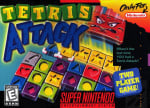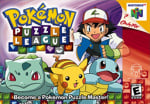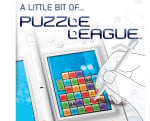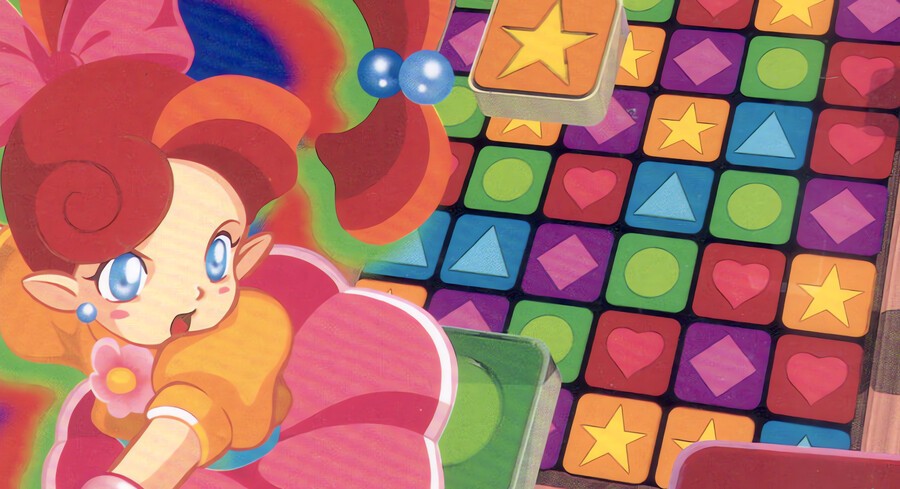
Most players would agree that Nintendo absolutely delivered when it came to the Super Smash Bros. Ultimate roster — recruiting a wide array of long-awaited characters to duke it out alongside their fellow greats. With the seeming shift in focus from Nintendo’s own characters towards third-party superstars, players would be forgiven thinking the well may have run dry for the gaming giant’s own additions. As any number of wish lists and video essays will attest, this is clearly not the case. Discussions on the topic happen frequently, emphasizing elements like popularity and impact, but even this discourse can leave more obscure series out of the conversation.
Panel de Pon is just such a series — one players may have only heard of in passing (or perhaps not at all). The colourful block puzzler has been a part of both Nintendo and Smash Bros.’ history for decades. It has an established main character, multiple entries, time-tested gameplay, and occupies a unique niche in the company’s extensive library. To understand why players haven’t seen an official entry in the Panel de Pon series in over 25 years and why protagonist Lip may have been left out of Nintendo’s most recent brawler, one needs to understand where the series began and how it has progressed.
Unlike many “forgotten” titles in Nintendo’s vast library, Panel de Pon never really went away. While the branding has shifted, the initial gameplay mechanics have remained, letting the series become something of a paradox, one that never truly lost its identity despite changing appearances on multiple occasions.
Rising to the Occasion
The original Panel de Pon was developed in the early ‘90s by Intelligent Systems, who, until that time, were mostly an auxiliary programming unit for Nintendo, assisting in the development of various Famicom and NES titles. The developer’s most notable, original contribution at the time was (and arguably still is) the Fire Emblem series. Working on the classic turn-based strategy series, as well as other successful games, allowed Intelligent Systems to grow as a developer in their own right.
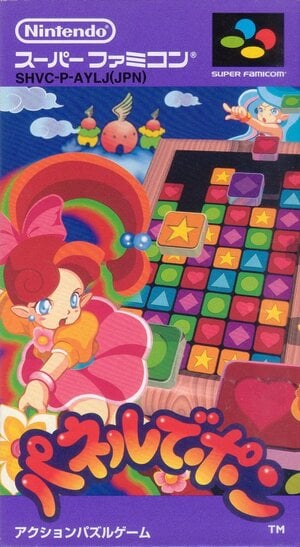
Starting the 16-bit era with a larger and more talented staff, Intelligent Systems not only continued their support for Nintendo’s core development teams (working on games such as Mario Paint and Super Metroid), but dove even deeper into the development of their own titles. Rather than another strategy title, the studio focused on a different type of grid-based gameplay, laying out the first piece of the charming, puzzling legacy that would be Panel de Pon.
Presumably named for the panel-like tiles that fill the screen and the way they “pop” (or “pon”) when matched, Panel de Pon brought a handful of interesting twists to the puzzle genre. To the untrained eye, it’s easy to see Panel de Pon’s colourful grid of shifting blocks and think, “Oh, another falling block puzzle game.” But little does one realize that the various blocks on screen don’t fall from the top; they actually rise from the bottom, a surprisingly important distinction.
The real game changer (no pun intended) in Panel de Pon was how players controlled a bracket-based cursor instead of blocks themselves. By highlighting a pair of squares, one could swap their positioning, shifting the two panels around to match shapes and colors on opposite sides. Doing so would clear the board, trigger potentially massive chain reactions, and fuel garbage drops — piles of blocks that fill up the screen and interrupt chains — on the side of one’s opponent.
Describing Panel de Pon gameplay in today’s market might not make it sound overly impressive, but at the time, both head-to-head puzzle games and puzzle games built around shifting objects (rather than guiding pieces) were still somewhat in their infancy. Panel de Pon managed to marry these ideas and include some of the most infectious combo-based clearing mechanics one could find at the time. It’s these deceptively simple mechanics that would inspire Nintendo to keep the series alive in various forms over the coming years.
Beyond the tile-swapping mechanic, Panel de Pon is far from a complex title. When the game launched on the Super Famicom in October of 1995, Japanese players were introduced to Lip, the adorable flower fairy on a quest to save her similarly-styled friends from encroaching monsters and an evil spell. Panel de Pon’s graphics are bright and simple, with a catchy soundtrack that suits both its pixels and its pixies. At a time when Nintendo was adding more layers to its established properties, and games were starting to tell more complex stories, it’s easy to see why the cute aesthetic of Panel de Pon may have been seen as lacking by many.
Therein may lie the roadblock to Panel de Pon’s potential prominence — Lip and friends are more a vehicle of the gameplay than entities in their own right. Even fans of the series agree, the characters don’t have much of a backstory and can be rightfully seen as cookie-cutter examples of the ‘90s anime aesthetic aimed at younger audiences. This fact is understandable, both for the time and the genre, though in all fairness, it gave Lip nearly as much personality as many of Nintendo’s own stable of characters at the time. If given a more prominent role, it’s not hard to believe Lip may have gained more of a cult following, rather than her current genre-specific fondness. Sadly, Lip wouldn’t get that chance, with Panel de Pon instead becoming a victim of a somewhat bizarre marketing and cross-brand mixture.
Attack of the Rebrand
When it came time to localize Panel de Pon, it was decided to completely do away with Lip and the fair folk. Reskinning puzzle games wasn’t a new concept at the time. Nintendo had done just that with Super Puyo Puyo on the Super NES a year earlier, reworking the game for North American and European audiences as Kirby’s Avalanche and Kirby’s Ghost Trap respectively. While this move was more understandable, as Puyo Puyo developer Compile was offering up ports left and right, Intelligent Systems was firmly within the Nintendo fold, having made Panel de Pon specifically for the Super Famicom. Despite all this, when the game finally arrived on Super NES in the summer of 1996, it had been given a complete makeover. Panel de Pon was now Tetris Attack.
There are a handful of issues with the title Tetris Attack. The most glaring is the fact that, outside of the game involving blocks that needed to be arranged in a specific pattern before one’s board fills, Tetris Attack had virtually no semblance to the gaming legend that is Tetris. One can’t fault Nintendo for wanting to associate their new game with the brand after its phenomenal performance on the Game Boy and beyond, but even Tetris Company co-founder Henk Rogers has gone on record stating he regrets allowing the Tetris name to adorn the Panel de Pon reskin.
The other curious aspect of that title is that it doesn’t capitalize on the game’s new star — Yoshi. The entire game was reworked using characters from 1995’s Super Mario World 2: Yoshi’s Island, highlighting the game’s marker-drawn aesthetic while maintaining the puzzle gameplay. And while few can argue the appeal of Yoshi’s Island and Yoshi’s overwhelming cuteness, it’s still quite an odd choice when stacked side-by-side with the game’s new moniker. In the end, players got a pile-up of Tetris and Mario branding in a game that initially had nothing to do with either. It seemed Lip would be lost to a void of unmarketable obscurity, a victim of both time and timing when compared to Nintendo’s willingness to localize titles these days.
Even with coexisting properties factored in, Tetris Attack didn’t make quite the splash Nintendo had hoped. The game found its fair share of fans and sold decently well, but was easily overshadowed by the looming launch of the Nintendo 64. And while a directly translated port of Panel de Pon might not have done as well, both the Tetris and Yoshi series had very little to lose by failing to attract more attention. Tetris continues to be, without question, one of the most recognizable video games in the world, While Yoshi remains an established character in the Mario franchise and their own unique games. The only series that took a hit here was poor Panel de Pon.
Gotta Stack’em All
While it didn’t seem like the original cast of Panel de Pon were getting much work, Nintendo did see fit to keep the original game alive in an interesting way. The Satellaview was a Super Famicom’s satellite add-on that allowed players to beam new games and content directly into their homes, a wild concept for the mid ‘90s. Panel de Pon showed up on the Satellaview not once, but four times, with the release of BS Panel de Pon Event Version, BS Panel de Pon Event Version 2, BS Panel de Pon Event ‘98, and Yoshi’s Panel de Pon. Yes, the visual changes that came with the Tetris Attack rebranding were brought back to Japan, not only on the Super Famicom, but also on the Game Boy. Despite being named Yoshi’s Panel de Pon, Lip and Company were nowhere to be found.
Fast forward to the turn of the millennium, nearing the end of the Nintendo 64 era, and somehow the Panel de Pon series would manage to surprise players once again. Not one, but two Panel de Pon titles released in the year 2000, this time rebranded not with Yoshi’s smiling face, but two very different coats of Pokémon paint.
Both Pokémon Puzzle Challenge for the Game Boy Color and Pokémon Puzzle League for the Nintendo 64 maintained the core of the original Panel de Pon, with the handheld version seeming almost like a direct sequel. Puzzle Challenge kept a lot of the visual choices found in the Super Famicom release, with a Pokémon Gold And Silver twist. This included an absolutely incredible soundtrack based on the pair of Johto journeys. In Japan, the game was even titled Pokémon Panel de Pon, keeping the brand alive without a single fairy present. (Togepi doesn’t count.)
In contrast, Pokémon Puzzle League was based completely on the series’ anime adaptation, an angle the Pokémon games rarely touch. Unlike Puzzle Challenge, Puzzle League wasn’t released in Japan, and surprisingly remains (for the most part) a Western exclusive. Perhaps the most notable aspect of the Nintendo 64 entry is that it would be the first game in the Panel de Pon family to use what would go on to become its “official” localized designation — Puzzle League.
While it would appear this pair of Pokémon puzzlers proved Nintendo’s continued lack of faith in the Panel de Pon branding and original world, both actually managed to play a part in the series’ history in unique ways. The most interesting connection was found in Puzzle Challenge, where players could input a particular code to uncover a fully playable mobile version of Panel de Pon, complete with Lip! It would be her first appearance in a game since 1995, and seems to indicate that at some point, a legitimate Panel de Pon Game Boy Color title was planned before it shifted to Puzzle Challenge. As for Puzzle League, its role in Lip’s legacy wouldn’t be clear until a few years later.
A League of Their Own
In 2003 Nintendo made a spectacular move, albeit one that remained only in Japan. The gaming giant turned back the clock and put out a compilation release of three classic puzzle titles known as Nintendo Puzzle Collection on the handled-wonder that is the GameCube. All of the games involved had been updated graphically and received multiplayer modes, catching up with modern expectations for gaming’s sixth generation. The virus-busting Dr. Mario was joined by fellow NES-era title Yoshi’s Cookie and… a completely new Panel de Pon! Well, more like half-new.
Not only was this new Panel de Pon sporting updated art assets, the game was also a sequel in terms of puzzle lore, starring descendants of the original cast and adding small story cutscenes. Structurally, however, the game appeared to be a reskinned version of Pokémon Puzzle League, one that had finally made its way to Japan. Decades later, with the discovery of a prototype Nintendo 64 cartridge, fans would find out that it was actually Pokémon Puzzle League that had been reskinned. The Pokémon puzzler had originally been Panel de Pon 64, with much of what is known about this prototype version being found eventually on Puzzle Collection. It’s a fascinating back and forth, and yet again, the result is two very different takes on the game’s branding depending on which side of the Pacific players lived.
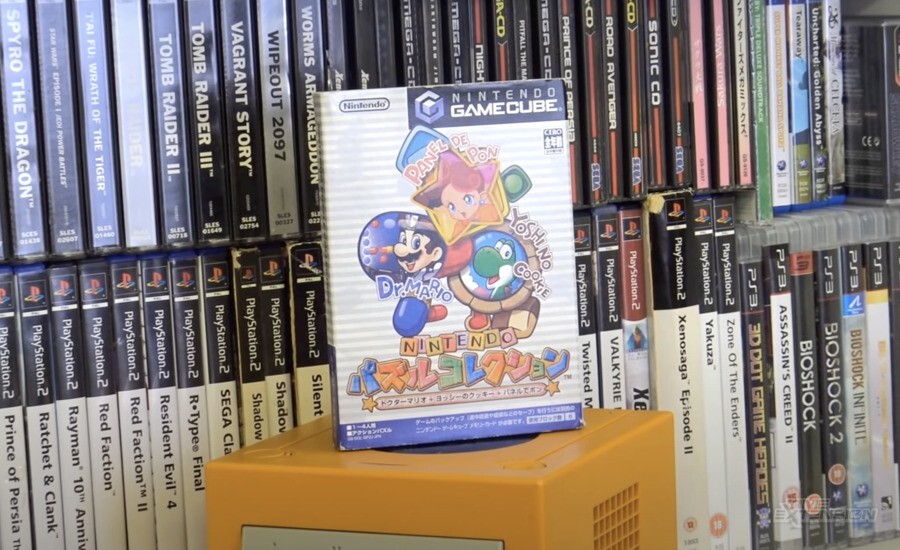
While there were hints of Puzzle Collection getting a Western release at E3 2003, nothing ever came of these rumours. To this day, the game remains one of the most frequent GameCube import recommendations, standing shoulder to shoulder with quirky titles like Doshin The Giant and Donkey Konga 3.
While Puzzle Collection wasn’t a true crossover, it’s worth mentioning another Panel de Pon appearance which also took place on the GameCube. Super Smash Bros. Melee shattered expectations of what Nintendo could do with the fledgling arena fighting series, and managed to show the Panel de Pon series some love in the process. Lip’s Stick, a large flowering staff used by Lip in the original game (not to be confused with makeup mainstay lipstick), was added to Melee as an item and has been included in the Smash Bros. series for over twenty years.
A nod to the series can also be found in Kirby’s down special (Stone), wherein he momentarily transforms into a pink Garbage Block to crush his enemies. While included, Panel de Pon’s place in Smash Bros. has always been fringe at best, with a single remixed music track and a smattering of stickers, spirits, and Mii Fighter Costumes introduced over the years. From these small additions, it’s evident that Smash Bros. and Kirby creator Masahiro Sakurai has some fondness for the series, though players are likely still a ways off from a Lip amiibo hitting store shelves.
For the next few years, Panel de Pon’s place in the Nintendo library was effectively locked to miniature tributes in Super Smash Bros. A handful of handheld releases would drop every few years from that point on, and while they carried the Panel de Pon name in Japan, it was at this point that Nintendo fully committed to the Puzzle League rebrand elsewhere. Dr. Mario & Puzzle League (Game Boy Advance, 2005), Planet Puzzle League / Puzzle League DS / Panel de Pon DS (DS, 2007), and Puzzle League Express (DSi, 2009) would all come and go without much fanfare. Each entry still carried the series’ excellent gameplay, even introducing some new modes here and there, but Lip and friends seemed to be a distant and unreachable memory.
Based on Nintendo’s willingness to support the Dr. Mario series with re-releases and digital-only sequels, there’s some credibility to the assumption that Nintendo Puzzle Collection may have been held back in the West due to the same concerns as the original Panel de Pon, or possibly an inability to utilize the Tetris Attack name for a re-release. Whether that IP indiscretion played a part in the series’ momentum moving forward can’t be confirmed, but for the better part of a decade, it meant Panel de Pon was effectively scrubbed of all its original charm in favour of a sterile style that effectively made the Puzzle League tiles themselves the series’ new mascot.
Lip Service
For better or worse, Lip managed to sneak in an appearance in the Japan-exclusive Wii oddity Captain Rainbow, a game whose sole focus was on forgotten and underutilized characters. The flower fairy found herself sharing the spotlight with not-so-forgotten characters like Birdo and Little Mac (before his Wii comeback), as well as nameless infantry from Famicom Wars and the playable golfer from… Golf.
There’s a strange mix of shame and pride that comes with being included alongside other Nintendo misfits and losers, but Lip’s appearance was ultimately a fun nod to Japanese players who had followed the series since its inception. If fans of Panel de Pon had been holding out hope for Lip to make an appearance in a modern title, at least they had Captain Rainbow to point towards. Unfortunately, her inclusion didn’t exactly play to the strength or legacy of her notable origin — a bit player in a game about bit players.
While not a full revival, Panel de Pon would pop up unexpectedly in 2016. Originally released in 2012, Animal Crossing: New Leaf was a runaway hit for the Nintendo 3DS. Four years after launch, with interest in the game waning, players were offered a special “Welcome amiibo” update. Part of this outpouring of NFC cards and bonus content was an in-game New Nintendo 3DS item that could be displayed in one’s virtual home. Interacting with said digital 3DS, players could access an entirely new Puzzle League offering within Animal Crossing, featuring blocks styles after different fruit one could procure in the game.
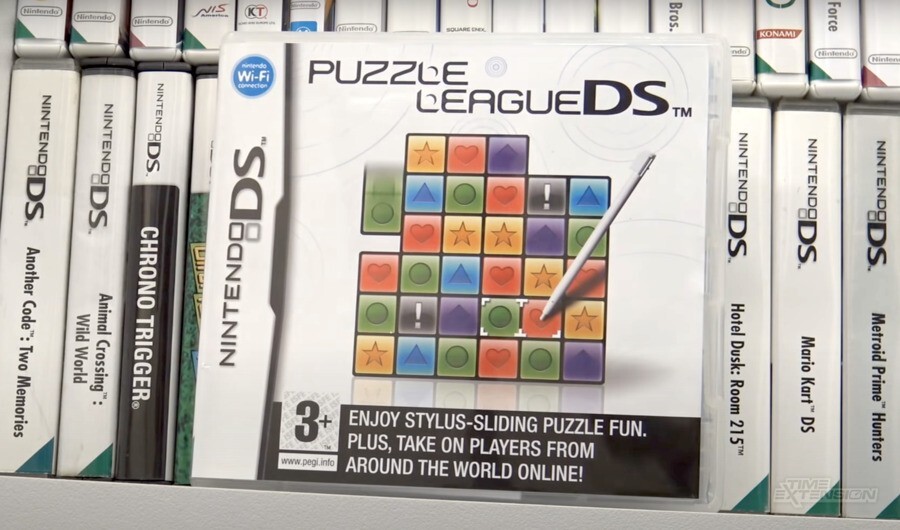
Not only was this the first time a title for the series had appeared outside of an eShop release in roughly seven years, it was also somewhat true to the spirit of the original Panel de Pon. The team behind Animal Crossing did their best to carry over the experience, even adding unlockable items and outfits based on Lip’s original look. Though more of a mini-game than a full title, the inclusion of Panel de Pon (now Puzzle League) sparked some overdue attention for the series.
In what’s likely been the biggest surprise for the Panel de Pon faithful in recent memory, Nintendo made the decision to bring back the original game in the year 2020. In the midst of rolling out titles not named EarthBound, Nintendo announced it would finally be adding the classic Super Famicom puzzler to its growing library of online offerings, not just in Japan, but throughout all regions.
Though this version of Panel De Pon remained surprisingly untranslated, like the handful of Nintendo Online Japan-exclusives before it, the game was finally back. Outside of the secret, embedded Game Boy version found in Pokémon Puzzle Challenge two decades before, this was the first time Lip was truly free to frolic and play in nearly 25 years, on one of Nintendo’s best-selling consoles, no less! It may not have been enough to reignite a fire that, frankly, wasn’t burning very bright to begin with, but it was enough to bring a bit of hope to Panel de Pon fans the worldover.

Regardless of what Nintendo may (or may not) make happen in terms of the series’ future, Panel de Pon will remain a bright blip in the vast ocean that is gaming history. And if this retrospective has shown us anything, it’s the fact that Panel de Pon never really went away. The series wore many hats, and took a break or two, but its gameplay and allure have changed very little.
With Nintendo bringing back series like Famicom Detective and Advance Wars, it’s not too far-fetched to think Panel de Pon could see a new, possibly digital-only, entry in the coming years. After all, puzzle games are quite well represented on Switch already. Players have been treated to a puzzle battle royale with Tetris 99, multiple entries in the Puyo Puyo series (including actual crossovers with Tetris rather than just a borrowed name), and even some games clearly inspired by Panel de Pon (check out Petal Crash). Surprisingly, Nintendo themselves haven’t put out a dedicated puzzle game on their handheld hybrid to date. With any luck, Panel de Pon could be their missing piece, and Lip the one to place it.
This feature originally appeared on Memory Card Show and has been republished here with kind permission.

